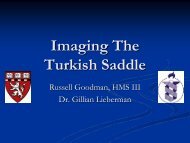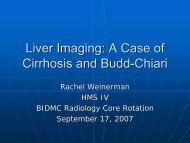The Basics of MRI: T1 vs. T2
The Basics of MRI: T1 vs. T2
The Basics of MRI: T1 vs. T2
Create successful ePaper yourself
Turn your PDF publications into a flip-book with our unique Google optimized e-Paper software.
Frank Minja, HMS III<br />
Gillian Lieberman, MD<br />
A Pulse <strong>of</strong> Radi<strong>of</strong>requency<br />
• Once the tiny magnetic moments are in equilibrium with the external<br />
magnetic field, they will continue to be aligned and precess about the<br />
vertical axis.<br />
• A pulse <strong>of</strong> radi<strong>of</strong>requency (RF) will disrupt the equilibrium causing<br />
the tiny magnetic moments to fall out <strong>of</strong> alignment with the external<br />
magnetic field.<br />
• Following the RF pulse, the tiny magnetic moments will tend towards<br />
their original state <strong>of</strong> alignment and precession around the vertical axis<br />
• As the magnetic moments re-align themselves, they release energy in<br />
the form <strong>of</strong> radiowaves.<br />
• <strong>The</strong>se radiowaves are the <strong>MRI</strong> signals!<br />
• A Pulse <strong>of</strong> Radi<strong>of</strong>requency (RF)<br />
6
















